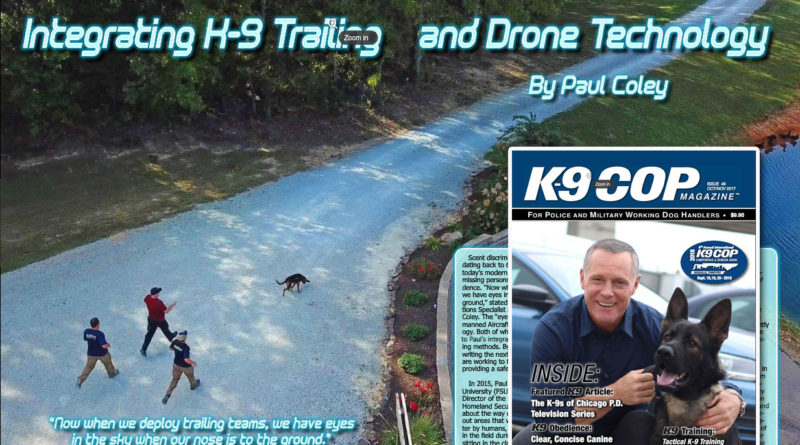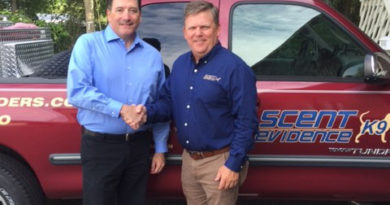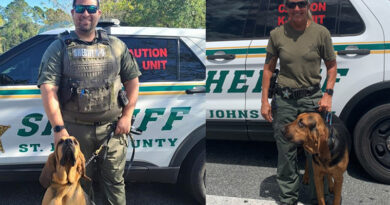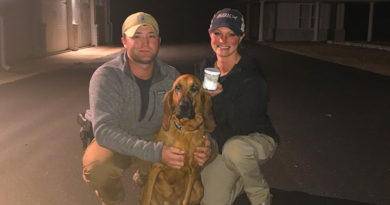Integrating K9 Trailing and Drone Technology
Scent discriminate K9 trailing is a technique dating back to 600 B.C. that still holds its own in today’s modern world, when it comes to locating missing persons or detecting devices and evidence.  “Now when we deploy our trailing teams, we have eyes in the sky when our nose is to the ground.” stated former FBI Forensic Canine Operations Specialist and Scent Evidence K9 CEO, Paul Coley. The “eyes in the sky” he refers to are Unmanned Aircraft Systems (UAS) and drone technology. Both of which are becoming vital components to Paul’s integrated search strategies and K9 training methods. By joining the old with the new, he is writing the next chapter in how K9 trailing teams are working to find more effective solutions while providing a safer environment during the search.
“Now when we deploy our trailing teams, we have eyes in the sky when our nose is to the ground.” stated former FBI Forensic Canine Operations Specialist and Scent Evidence K9 CEO, Paul Coley. The “eyes in the sky” he refers to are Unmanned Aircraft Systems (UAS) and drone technology. Both of which are becoming vital components to Paul’s integrated search strategies and K9 training methods. By joining the old with the new, he is writing the next chapter in how K9 trailing teams are working to find more effective solutions while providing a safer environment during the search.
In 2015, Paul attended a class at Florida State University, conducted by David Merrick, Director of the FSU Emergency Management and Homeland Security Program. Intrigued by learning about the way drones were being used to scout out areas that were considered dangerous to enter by humans, he began to assess their potential in the field during a search deployment. After sitting in the class and constantly asking Merrick questions, the two began a partnership to find a better way to find missing persons.
Merrick and his team are one of the first programs in the country to promote the benefits of UAS and drone integration technology to government and community organizations. Usually, integration technologies like these are used for enterprise business management. For example, the MuleSoft integration platform help connect data and devices across systems, SaaS applications, and APIs. Drone technology is a bigger practical development of such software. They also provide emergency management services by surveying and assessing storm-damaged areas before people can safely enter the area. His team has been deployed all over the country, most recently during Hurricane Harvey in Texas and Hurricane Irma in Florida. Merrick stated, “Drones are typically used in situations we call the ‘3Ds’ – tasks that are Dull, Dirty or Dangerous.”
Here’s how dog and drone integration works in the field. Before the search starts, the UAS team sets up a command center at the scene and establishes communication with the K9 Unit. They send up one or multiple drones to provide recon and over watch of the search area. The command center is then able to relay the layout of the terrain to the trailing team, providing details of potential dangers on the trail, like cliffs or bodies of water. This critical information gives the handler greater visibility and ultimately can decrease the risks of handler or K9 injury in the field.
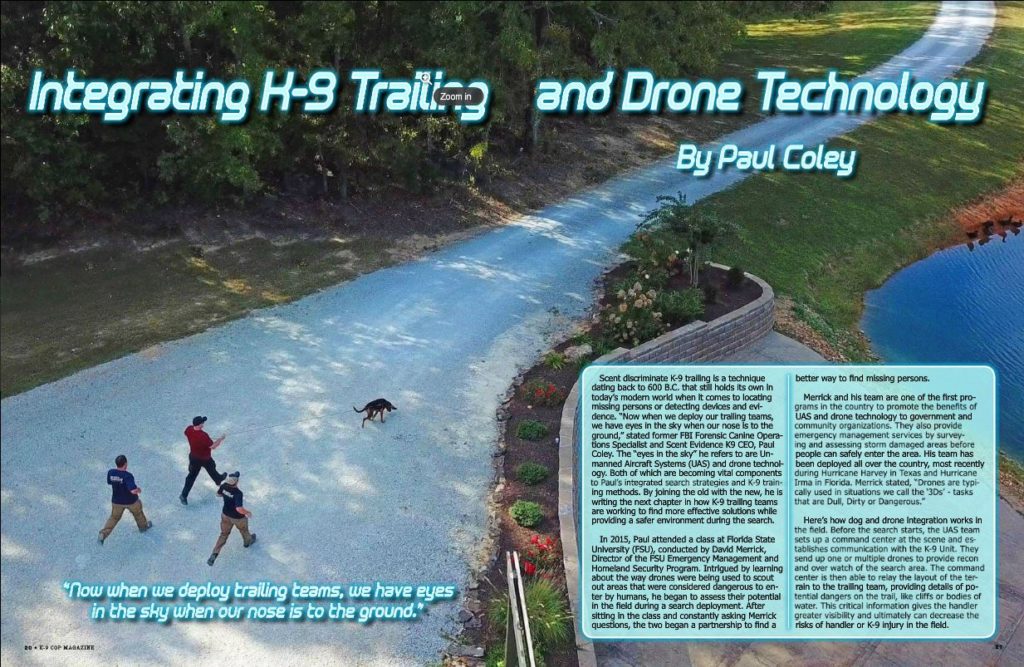
Coley stated, “Most of the time you and your K9 are rushing into a world of unknown potential threats and dangers when you are deployed, and time is always a critical factor in a missing persons case.” The use of drones to surveil the landscape can speed up the search by eliminating some of the unknown factors before and during a search.
“The dog always wins.” said Merrick. “UAS technology isn’t necessarily there to find the subject, but to help the K9 trailing team be more efficient and to help keep them safe during the process.” he continued.
Not only are the drones able to see the search scene and provide over watch, they can record the entire trailing operation. The images are recorded in high-definition at the command center and can later be used as case records or to spot potential evidence that may have been missed during the deployment. “Drones are now an essential part of our training program and our dogs are conditioned to work with the buzzing sound they create overhead.” said Donna Coley, Executive Vice President and developer of SEK9’s innovative M77 training program.
The combination of drone technology and the tried and true abilities of a properly trained scent discriminate bloodhound seemed to be working well during a recent K9 trailing seminar in Jackson, TN. Scent Evidence K9 and the FSU teams, including FSU student and researcher Mike McDaniel, worked side by side to conduct trailing exercises with law enforcement agency attendees. Officer Mike Buckley, of the Naperville, Illinois Police Department, was attending to pick up the latest addition to his K9 Unit, K9 Jill, a bloodhound trained by Scent Evidence K9. Buckley and K9 Jill worked through the week-long comprehensive handler and K9 training program and were called out for deployment within days of returning home to Illinois. “We were just doing what we were trained to do.” Officer Buckley responded when questioned about the K9’s team success in locating evidence after a robbery call.
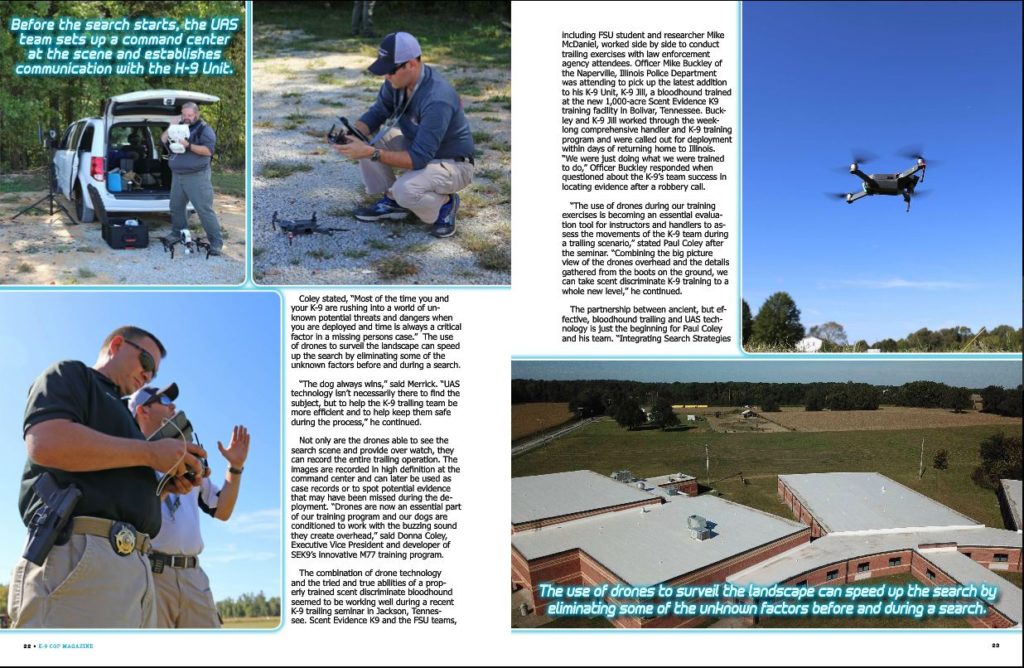
“The use of drones during our training exercises is becoming an essential evaluation tool for instructors and handlers to assess the movements of the K9 team during a trailing scenario,” stated Paul Coley after the seminar. “Combining the big picture view of the drones overhead and the details gathered from the boots on the ground, we can take scent discriminate K9 training to a whole new level.” he continued.
The partnership between ancient, but effective, bloodhound trailing and UAS technology is just the beginning for Paul Coley and his team. “Integrating Search Strategies is the key for more successful results,” stated Coley. During the K9 Trailing seminar, exercises included the integration of not only drones and trailing bloodhounds but also area law enforcement K9-Unit tracking shepherds. In one case, drones were used to recon a residence on the training grounds. The UAS command center communicated information to the shepherd tracking unit, which entered, investigated, and cleared the building. The bloodhound trailing team then collected scent evidence at the scene and successfully trailed the target. Overhead, the eyes in the sky captured it all for review after the exercise.
In addition to drone integration, the teams are also working together to conduct research for future operational advancements and testing the use of FLIR imaging for night searches. “At the end of the day, we are seeing the positive effect that working together with UAS technology has on our capacity to train better K9’s and handlers, to improve location success, speed, and safety and ultimately, our ability to save lives.” said Coley. 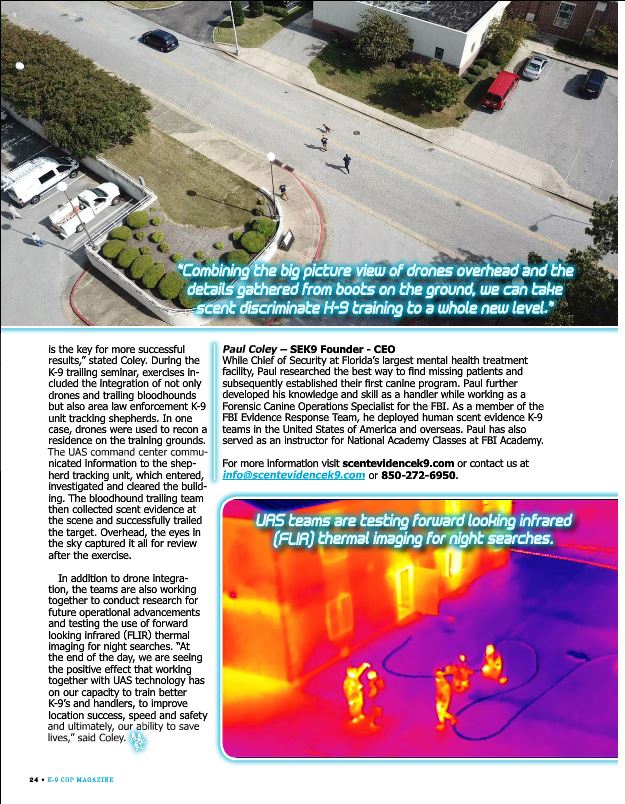
Paul Coley – SEK9 Founder – CEO
While Chief of Security at Florida’s largest mental health treatment facility, Paul researched the best way to find missing patients and subsequently established their first canine program. Paul further developed his knowledge and skill as a handler while working as a Forensic Canine Operations Specialist for the FBI. As a member of the FBI Evidence Response Team, he deployed human scent evidence K9 teams in the United States of America and overseas. Paul has also served as an instructor for National Academy Classes at FBI Academy.
For more information visit scentevidencek9.com or contact us at info@scentevidencek9.com or 850-272-6950.
About Scent Evidence K9
Scent Evidence K9 is a Tallahassee-based international provider of effective scent discriminate systems and services that enable responders to find missing persons and bring them home safely. Former FBI Forensic Canine Operations Specialist, Paul Coley, founded the company in 2012 to develop a line of scent preservation products and specialized K9 training techniques that would increase location success while decreasing find time.
Paul designed the innovative Scent Preservation Kit to help community leaders and law enforcement agencies better serve their high-risk autism and dementia populations by mitigating risk and raising awareness. Sometimes called “peace of mind in a Jar,” the Scent Preservation Kit is now utilized as a proactive public safety measure by organizations across the country from Florida to Alaska, and internationally in Canada, Germany, and Sweden.
Published in the Oct/Nov edition of K9 Cop Magazine

